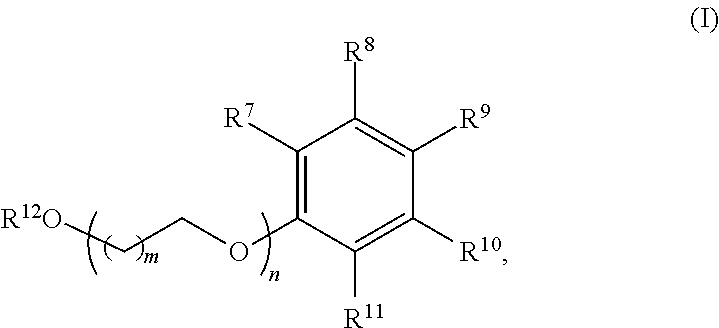Methods and compositions for use in oil and/or gas wells
a technology for oil and gas wells and compositions, applied in the direction of chemistry apparatus and processes, folding cabinets, cabinets, etc., can solve the problems of large quantities of injected fluids trapped in formations, affecting the productivity of wells, and difficult to achieve the necessary characteristics. to achieve optimal characteristics,
- Summary
- Abstract
- Description
- Claims
- Application Information
AI Technical Summary
Benefits of technology
Problems solved by technology
Method used
Image
Examples
example 1
[0167]This example describes a non-limiting experiment for determining displacement of residual aqueous treatment fluid by formation crude oil. A 25 cm long, 2.5 cm diameter capped glass chromatography column was packed with 77 grams of 100 mesh sand or a mixture of 70 / 140 mesh shale and 100 mesh sand or a mixture of 70 / 140 mesh shale and 100 mesh sand. The column was left open on one end and a PTFE insert containing a recessed bottom, 3.2 mm diameter outlet, and nipple was placed into the other end. Prior to placing the insert into the column, a 3 cm diameter filter paper disc (Whatman, #40) was pressed firmly into the recessed bottom of the insert to prevent leakage of 100 mesh sand. A 2 inch piece of vinyl tubing was placed onto the nipple of the insert and a clamp was fixed in place on the tubing prior to packing. The columns were gravity-packed by pouring approximately 25 grams of the diluted microemulsions (e.g., the microemulsions described in Examples 1 or 2, and diluted wit...
example 2
[0168]This example describes a non-limiting experiment for determining displacement of residual aqueous treatment fluid by formation gas. A 51 cm long, 2.5 cm inner diameter capped glass chromatography column was filled with approximately 410±20 g of 20 / 40 mesh Ottawa sand and the diluted microemulsions. To ensure uniform packing, small amounts of proppant were interchanged with small volumes of liquid. Periodically the mixture in the column was homogenized with the help of an electrical hand massager, in order to remove possible air pockets. Sand and brine were added to completely fill the column to the level of the upper cap. The exact amounts of fluid and sand placed in the column were determined in each experiment. The column was oriented vertically and was connected at the bottom to a nitrogen cylinder via a gas flow controller pre-set at a flow rate of 60 cm3 / min. The valve at the bottom was slowly opened and liquid exiting the column at the top was collected into a tarred jar...
example 3
[0169]This example describes a general preparation method for the production of diluted microemulsion. The microemulsions were prepared in the laboratory by mixing the ingredients listed in specific examples. All ingredients are commercially available materials. In some embodiments, the components were mixed together in the order water-alcohol-surfactant-citrus terpene solvent, but other order of addition may also be employed. The mixtures were then agitated on a magnetic stirrer for 5 10 minutes. The microemulsions were then diluted to concentrations of 1 or 2 gallons per 1000 gallons with 2% KCl brine and these diluted fluids were used in displacement experiments (e.g., as described in Examples 1 and 2).
PUM
| Property | Measurement | Unit |
|---|---|---|
| diameters | aaaaa | aaaaa |
| diameters | aaaaa | aaaaa |
| diameters | aaaaa | aaaaa |
Abstract
Description
Claims
Application Information
 Login to View More
Login to View More - R&D
- Intellectual Property
- Life Sciences
- Materials
- Tech Scout
- Unparalleled Data Quality
- Higher Quality Content
- 60% Fewer Hallucinations
Browse by: Latest US Patents, China's latest patents, Technical Efficacy Thesaurus, Application Domain, Technology Topic, Popular Technical Reports.
© 2025 PatSnap. All rights reserved.Legal|Privacy policy|Modern Slavery Act Transparency Statement|Sitemap|About US| Contact US: help@patsnap.com



